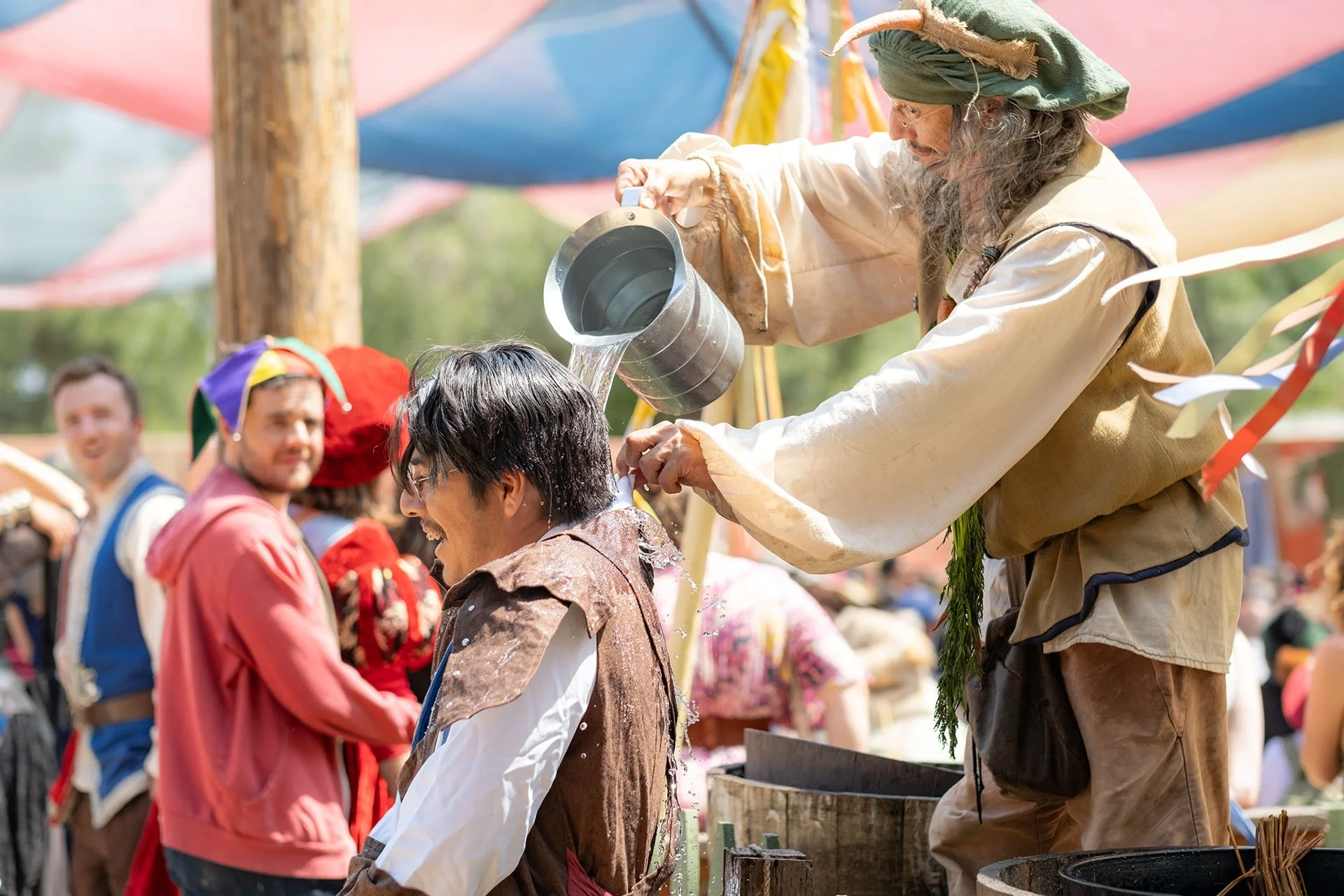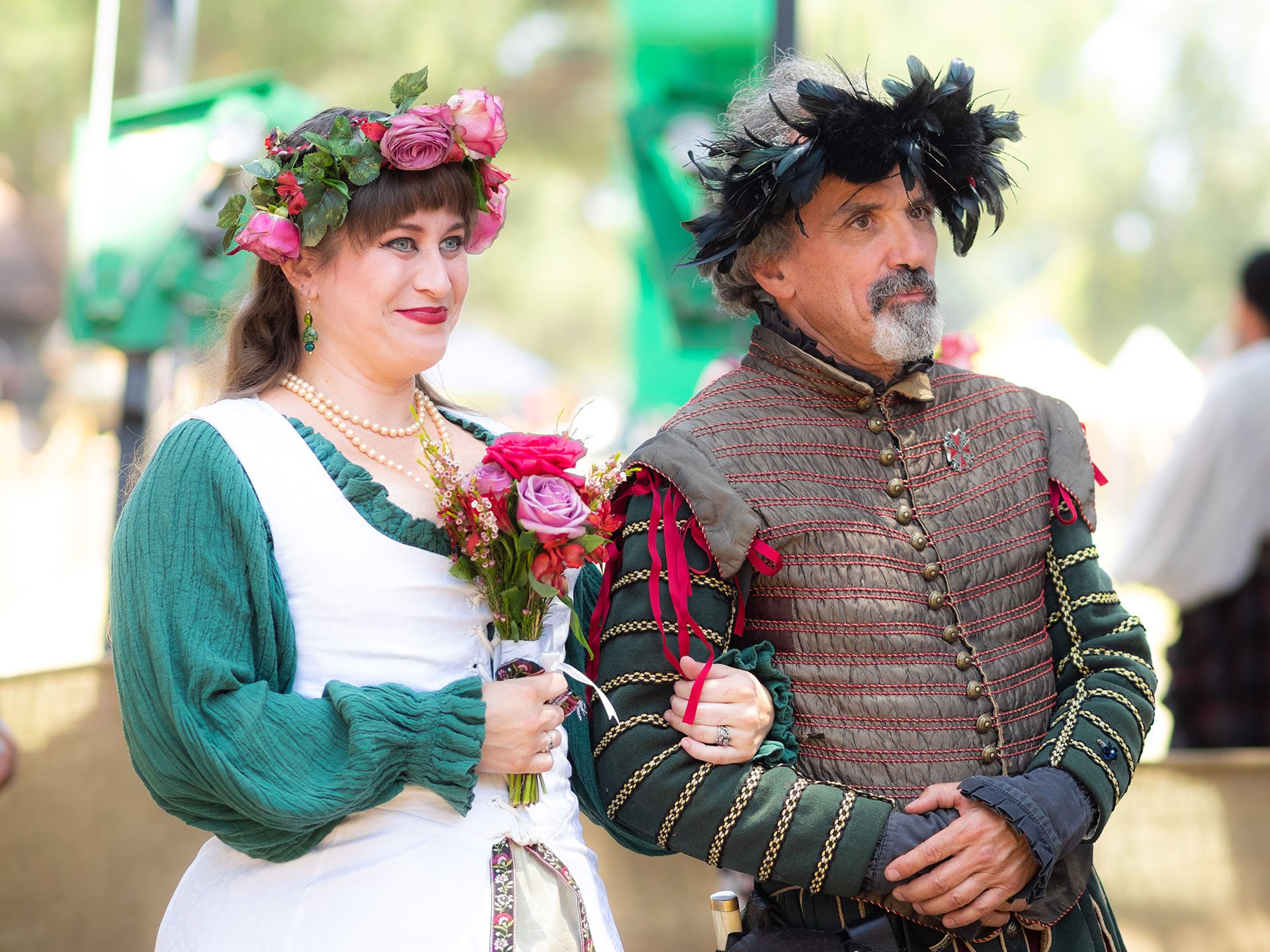SoCal Ren Fair
Famous for its film industrial complex, L.A.’s legacy as a crucible of live theater and immersive storytelling is just as weighty. Among its most original contributions to performance art is the Southern California Renaissance Faire: a living tapestry of heraldry, pageantry, and symbolic transformation.
Born from a summer camp in the burgeoning San Fernando Valley suburbs of the 1960s, the Faire evolved into an art form all its own. An elaborate world of spectacle and history, Faire is what happens when language, costume, and street theater merge into something deeply connective.
For seven weekends long the Faire conjures this dreamscape where history springs to life and collides with the collective imagination of its participants. Here, a bustling port town from 16th-century England materializes, teeming with merchants in hand-sewn garb imbued with ancestral meaning, and the omnipresent codes of European social hierarchy—filtered down through wealth and royalty.
A stage without walls, the Faire is a place where lord and commoner alike moves within a grand theatrical ritual, reciting words steeped in the poetry of Shakespeare and bawdiness of a seaside tavern. In its streets lie all the elements of a heroic mythology, told in real time by actors playing historicized personas of themselves.
My wife and I first encountered this strange world at the end of the 1990s, drawn in by its individual ability to prove how “all the world’s a stage.” Even as patrons, we somehow sensed that the real magic was privy only to those who lived within the performance, those who manifest the traditions, crafts, and interdependence of the time.
It was the early 2010s when we crossed the threshold, stepping into new identities as English Commoners within the Guild of St. Helena’s. Known for its wit, grit, and improvisation, Helena’s seminal flag is a pair of bloomers, well-worn and hoisted up a ragged tree limb. The guild’s motto ‘Semper Ubi, Sub Ubi’, an adage that speaks to the pragmatism of roles as Faire proletariat, translates to ‘always wear underwear’.
Seeking to understand the mysterious psychology that keeps so many of us coming back each season, I turn to my fellow Helena’s guild participants with questions. Kasey, guild master and 16-year Faire veteran, reflects on her early days as a hawker. Recognized quickly for a booming voice and busty profile, she was enlisted to the spectacle of the dunk tank, a role that yanks the wool of separation out from under patron and performer.
“You’re hard-pressed to find as many people who have your back, and who are here for you.” She says of the experience. For Kasey, Faire is a liminal space where fantasy and identity merge—“a place to be your inner crazy person for seven weeks.” This act of shedding one’s everyday mask and embodying a more authentic, theatrical self is a key part of the Faire’s enduring allure.
What of history itself? For Lance, eight-year Faire participant, the era it represents was ripe with revolution, intellectual ferment, and cultural synthesis. “The Renaissance was a major upheaval of ideas,” he says, drawn to the chance to engross himself in the period’s traditions and transformations.
Here, of course, historical accuracy is secondary to engagement. With less focus on rigid reenactment, Faire is a place “where you come to be entertained.” Yet, for Lance, the experience is deeply personal. A childhood memory of having been knighted at Northern Faire left a profound imprint on him, reinforcing the Faire’s ability to create moments of mythical resonance.
For mi tocayo, Alex, known by seemingly everyone at Faire as “Choko”, Faire participation has been nothing short of life-altering. Coming from a background of gang affiliations and deadly street violence, he entered its world as an outsider, unfamiliar with even the simplest phrases of its lexicon. But what he found here was more than an escape, it was a new kind of kinship.
“Blood family is family first, but it’s the people that keep me here.” Alex says. “You get to know and love them, and they keep me grounded.” In his eyes the Renaissance Faire is a reimagined social order. One where identity is intentional rather than imposed, and where belonging is cultivated through shared ritual and play. “It’s a different lifestyle, one where you choose the life you want to live.”
Meanwhile for Alfonso, stepping into costume as a first-time participant was less a leap into the unknown, and more a natural extension of the years he’d spent behind the scenes as part of crew. “It’s a lot of physical work, more than you anticipate,” he says, considering the extensive construction effort put in by the Guilds before Faire opens.
What surprises Alfonso most is the return on that investment. “You put so much energy into it, and you get it back quickly compared to the outside world.” And he notes finding something rare here: immediate connection. “Having Faire in common with someone is an instant ice breaker,” he says, noting how the language, gestures, and symbols create bonds faster than small talk ever could.
Even for newcomers, the power of the Faire’s artistry hits home. On the final day of her first season, Leora contemplates the experience with awe. She’d expected it to be fun, and exhausting, but hadn’t anticipated the commitment required to master the art of play. “Faire is a good outlet for that,” she says, noting how as an adult she’s rarely been given the space to engage in structured play. “I’ll carry [Faire] with me for the rest of my life.”
Beneath all the costumes and the revelry, the Southern California Renaissance Faire is an evergreen expression of artistry, symbolism, and transformation unlike any other. A transcendent destination where every detail—from the folds of a wool skirt to the inflection of a shouted “huzzah!”—carries a hidden meaning.
It’s not just a festival. Faire is a portal into a world where history, drama, and the boundless human spirit intertwine. Faire is a performance art form that harks back to the tight-knit communities of the old world while being perpetually reborn for a new season’s crowd.






